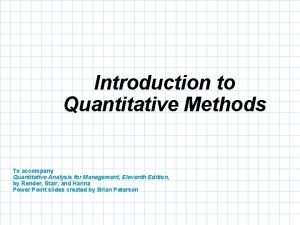Introduction to Quantitative Analysis for Management Dr Titus











- Slides: 11

Introduction to Quantitative Analysis for Management Dr. Titus Bitek Watmon Ph. D MSc BEng(Hons) MIET AMIMech. E Kyambogo University

What Is Quantitative Analysis? • Quantitative analysis is the scientific approach to managerial decision making. • The approach starts with data for example data on raw material for a factory, these data are manipulated or processed into information that is valuable to people making decisions. • This processing and manipulating of raw data into meaningful information is the heart of quantitative analysis. • Computers have been instrumental in the increasing use of quantitative analysis. • In solving a problem, managers must consider both qualitative and quantitative factors. 09 -Sep-17 Titus Watmon 2

Quantitative Analysis Approach • Define the Problem: The first step in the quantitative approach is to develop a clear, concise statement of the problem. • Developing a Model: a model is a representation (usually mathematical) of a situation. Types of Models; physical model, scale models and schematic model • Mathematical Model: A mathematical model is a set of mathematical relationships. In most cases, these relationships are expressed in equations and inequalities, as they are in a spreadsheet model that computes sums, averages, or standard deviations. 09 -Sep-17 Titus Watmon 3

Mathematical Model: Variables and Parameters. • A variable, variable as the name implies, is a measurable quantity that may vary or is subject to change. • Variables can be controllable or uncontrollable. • A controllable variable is also called a decision variable. An example would be how many inventory items to order. • A parameter is a measurable quantity that is inherent in the problem. The cost of placing an order for more inventory items is an example of a parameter. 09 -Sep-17 Titus Watmon 4

Mathematical Model Cont. . . • In most cases, variables are unknown quantities, • while parameters are known quantities. • All models should be developed carefully. • They should be solvable, realistic, and easy to understand modify, and the required input data should be obtainable 09 -Sep-17 Titus Watmon 5

Acquiring Input Data • Once we have developed a model, we must obtain the data that are used in the model (input data). • For a larger problem, collecting accurate data can be one of the most difficult steps in performing quantitative analysis • statistical sampling procedures can be used to obtain data. 09 -Sep-17 Titus Watmon 6

Developing a Solution • Developing a solution involves manipulating the model to arrive at the best (optimal) solution to the problem. • In some cases, this requires that an equation be solved for the best decision. • In other cases, you can use a trial and error method, trying various approaches and picking the one that results in the best decision. • Trying various steps to arrive at an optimal solution is called complete enumeration. • A series of steps or procedures that are repeated is called an algorithm, named after Algorismus, an Arabic mathematician of the ninth century 09 -Sep-17 Titus Watmon 7

Testing the Solution • Before a solution can be analyzed and implemented, it needs to be tested completely. • Because the solution depends on the input data and the model, both require testing. • Testing the input data and the model includes determining the accuracy and completeness of the data used by the model. • Inaccurate data will lead to an inaccurate solution 09 -Sep-17 Titus Watmon 8

Analyzing the Results • Analyzing the results starts with determining the implications of the solution. • In most cases, a solution to a problem will result in some kind of action or change in the way an organization is operating. • The implications of these actions or changes must be determined analyzed before the results are implemented. 09 -Sep-17 Titus Watmon 9

Sensitivity Analysis • model is only an approximation of reality, the sensitivity of the solution to changes in the model and input data is a very important part of analyzing the results. • This type of analysis is called sensitivity analysis or postoptimality analysis 09 -Sep-17 Titus Watmon 10

Implementing the Results • The final step is to implement the results. This is the process of incorporating the solution into the company. • This can be much more difficult than you would imagine. • Even if the solution is optimal and will result in millions of dollars in additional profits, if managers resist the new solution, all of the efforts of the analysis are of no value. 09 -Sep-17 Titus Watmon 11





















